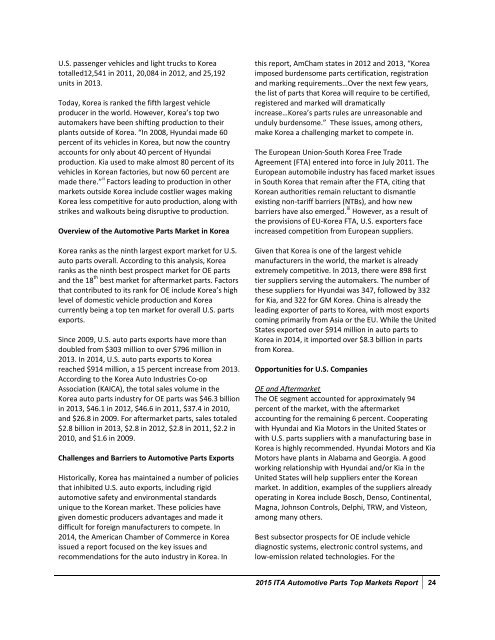Automotive Parts
Autoparts_Top_Markets_Report
Autoparts_Top_Markets_Report
You also want an ePaper? Increase the reach of your titles
YUMPU automatically turns print PDFs into web optimized ePapers that Google loves.
U.S. passenger vehicles and light trucks to Koreatotalled12,541 in 2011, 20,084 in 2012, and 25,192units in 2013.Today, Korea is ranked the fifth largest vehicleproducer in the world. However, Korea’s top twoautomakers have been shifting production to theirplants outside of Korea. “In 2008, Hyundai made 60percent of its vehicles in Korea, but now the countryaccounts for only about 40 percent of Hyundaiproduction. Kia used to make almost 80 percent of itsvehicles in Korean factories, but now 60 percent aremade there.” ii Factors leading to production in othermarkets outside Korea include costlier wages makingKorea less competitive for auto production, along withstrikes and walkouts being disruptive to production.Overview of the <strong>Automotive</strong> <strong>Parts</strong> Market in KoreaKorea ranks as the ninth largest export market for U.S.auto parts overall. According to this analysis, Korearanks as the ninth best prospect market for OE partsand the 18 th best market for aftermarket parts. Factorsthat contributed to its rank for OE include Korea’s highlevel of domestic vehicle production and Koreacurrently being a top ten market for overall U.S. partsexports.Since 2009, U.S. auto parts exports have more thandoubled from $303 million to over $796 million in2013. In 2014, U.S. auto parts exports to Koreareached $914 million, a 15 percent increase from 2013.According to the Korea Auto Industries Co-opAssociation (KAICA), the total sales volume in theKorea auto parts industry for OE parts was $46.3 billionin 2013, $46.1 in 2012, $46.6 in 2011, $37.4 in 2010,and $26.8 in 2009. For aftermarket parts, sales totaled$2.8 billion in 2013, $2.8 in 2012, $2.8 in 2011, $2.2 in2010, and $1.6 in 2009.Challenges and Barriers to <strong>Automotive</strong> <strong>Parts</strong> ExportsHistorically, Korea has maintained a number of policiesthat inhibited U.S. auto exports, including rigidautomotive safety and environmental standardsunique to the Korean market. These policies havegiven domestic producers advantages and made itdifficult for foreign manufacturers to compete. In2014, the American Chamber of Commerce in Koreaissued a report focused on the key issues andrecommendations for the auto industry in Korea. Inthis report, AmCham states in 2012 and 2013, “Koreaimposed burdensome parts certification, registrationand marking requirements…Over the next few years,the list of parts that Korea will require to be certified,registered and marked will dramaticallyincrease…Korea’s parts rules are unreasonable andunduly burdensome.” These issues, among others,make Korea a challenging market to compete in.The European Union-South Korea Free TradeAgreement (FTA) entered into force in July 2011. TheEuropean automobile industry has faced market issuesin South Korea that remain after the FTA, citing thatKorean authorities remain reluctant to dismantleexisting non-tariff barriers (NTBs), and how newbarriers have also emerged. iii However, as a result ofthe provisions of EU-Korea FTA, U.S. exporters faceincreased competition from European suppliers.Given that Korea is one of the largest vehiclemanufacturers in the world, the market is alreadyextremely competitive. In 2013, there were 898 firsttier suppliers serving the automakers. The number ofthese suppliers for Hyundai was 347, followed by 332for Kia, and 322 for GM Korea. China is already theleading exporter of parts to Korea, with most exportscoming primarily from Asia or the EU. While the UnitedStates exported over $914 million in auto parts toKorea in 2014, it imported over $8.3 billion in partsfrom Korea.Opportunities for U.S. CompaniesOE and AftermarketThe OE segment accounted for approximately 94percent of the market, with the aftermarketaccounting for the remaining 6 percent. Cooperatingwith Hyundai and Kia Motors in the United States orwith U.S. parts suppliers with a manufacturing base inKorea is highly recommended. Hyundai Motors and KiaMotors have plants in Alabama and Georgia. A goodworking relationship with Hyundai and/or Kia in theUnited States will help suppliers enter the Koreanmarket. In addition, examples of the suppliers alreadyoperating in Korea include Bosch, Denso, Continental,Magna, Johnson Controls, Delphi, TRW, and Visteon,among many others.Best subsector prospects for OE include vehiclediagnostic systems, electronic control systems, andlow-emission related technologies. For the2015 ITA <strong>Automotive</strong> <strong>Parts</strong> Top Markets Report 24


